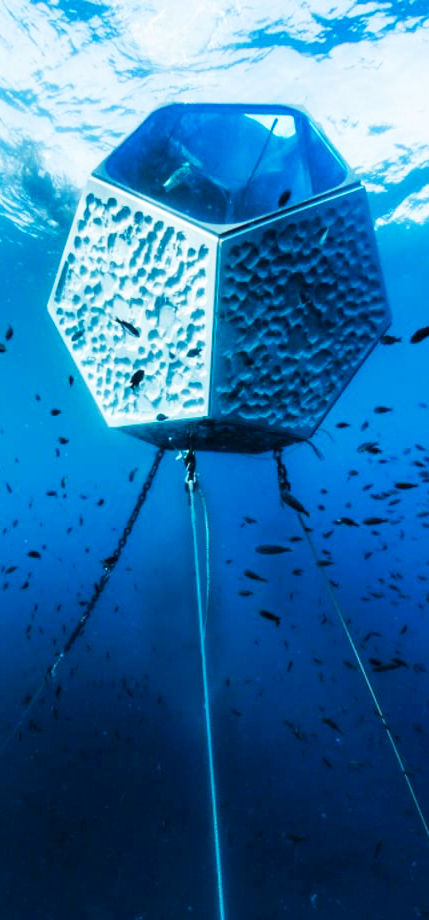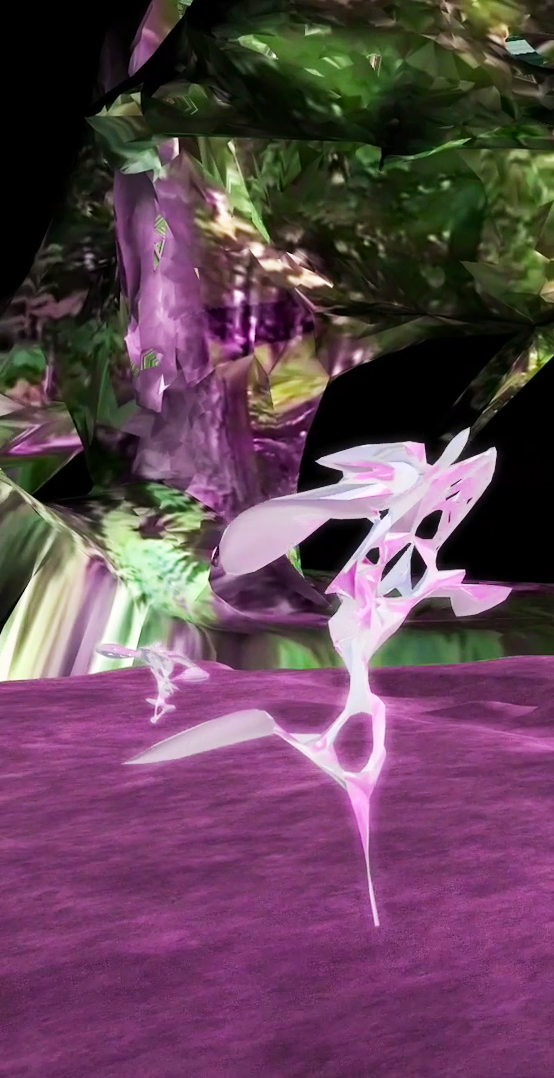
jamall osterholm
PINK
I explored the concept of a wearable that is either on or around the body and revisited a look that I had designed in a previous collection based on the concept of a 1920’s underwater invention.

PINK
I explored the concept of a wearable that is either on or around the body and revisited a look that I had designed in a previous collection based on the concept of a 1920’s underwater invention.

Underwater Pavilions
Underwater Pavilions is artist Doug Aitken’s large-scale installation produced by Parley for the Oceans and presented in partnership with The Museum of Contemporary Art, Los Angeles (MOCA). The work consists of three temporary underwater sculptures, floating beneath the ocean’s surface that swimmers, snorkelers, and scuba divers swim through and experience. Geometric in design, the sculptures create underwater spaces synthesizing art and science as they are constructed with carefully researched materials and will be moored to the ocean floor. Part of each structure is mirrored to reflect the underwater seascape and create a kaleidoscopic observatory for the viewer, while other surfaces are rough and rock-like. The environments created by the sculptures will constantly change with the currents and the time of day, focusing the attention of the viewer on the rhythm of the ocean and its life cycles.

Immersed Garden
Immersed Garden is in its true sense a sunken world. Floating bodiless in an underwater garden, natural sounds guide you through an immersive surrounding, somewhere between calming and irritating, natural and artificial. It is a playful exploration of the individual conception of safety and confusion and a personal approach to aesthetic references to habits of introspection and retreat in digital environments. It was created by fusing different digital processes like photogrammetry of selected natural places around Karlsruhe and field recordings in a local natural reserve. Underwater videos hybridize with 3D scans of trees and plants while invisible frogs are croaking and humming birds are buzzing by synthetic flowers. The artistic aim was to explore the personal perception of calming and irritating, playing with the concept of immaterialness and attentiveness. The artwork creates aesthetic references to philosophical and scientific theories of introspection and identity.

Scale
‘scale’ is an interspecies art project: an audience-interactive installation that involves nocturnal electric fish from the Amazon River Basin. Twelve different species of these fish comprise a choir whose sonified electrical fields provide the source tones for an immersive audiovisual environment. The fish are housed in individual tanks configured in a custom-built sculptural arc of aluminum frames placed around a central podium. The electrical field from each fish is translated into sound, and is thus heard — unprocessed or with digital effects added, with immediate control over volume via a touchscreen panel — through a 12-channel surround sound system, and with LED arrays under each tank for visual feedback. All software is custom-designed. Audience members interact as deejays with the system. Amongst the goals of the project is our desire to foster wider public awareness of these remarkable creatures, their importance to the field of neurological research, and the fragility of their native ecosystem.The project leaders comprise visual/conceptual artist Marlena Novak, composer/sound designer Jay Alan Yim, and neural engineer Malcolm MacIver. MacIver’s research focuses on sensory processing and locomotion in electric fish and translating this research into bio-inspired technologies for sensing and underwater propulsion through advanced fish robots. Novak and Yim, collaborating as ‘localStyle’, make intermedia works that explore perceptual themes, addressing both physical and psychological thresholds in the context of behavior, society/politics, and aesthetics.

ArchaeaBot: A Post Climate Change, Post Singularity Life-form
“ArchaeaBot: A Post Singularity and Post Climate Change Life-form” takes the form of an underwater robotic installation that explores what ‘life’ might mean in a post singularity, post climate change future. The project is based on new research about archaea (the oldest life forms on Earth) combined with the latest innovations in machine learning & artificial intelligence creating the ‘ultimate’ species for the end of the world as we know it.

EON
“I considered the first life forms on Earth and how we came to be as a way to refer to the Natural Sciences. I looked at fossil records of the first multi cellular organisms of the Ediacaran Period, 555 million years ago for inspiration. I was struck by the theory of symbiosis in evolution; our DNA ancestors are the resultant fusion of single cellular organisms and bacteria. The millions of bacteria in our bodies are our foremothers. EON is a speculative fiction, a depiction of early life forms underwater. The Universe was formed 13.7 billion years ago. The Earth is 4.543 billion years old. Cyanobacteria or blue-green algae were the first microbes to create oxygen on Earth via photosynthesis 3.5 billion years ago. First humans 200,000-300,000 years ago.” Jennifer Steinkamp

Amphibio
AMPHIBIO is made out of a special porous hydrophobic material which supports underwater breathing by replenishing oxygen from the surrounding water and dissipating carbon dioxide which accumulate in the system, inspired from the gill of water diving insects. The material can be shaped in complex form using 3D printing. Patent pending.

フィリップ·ラメット
Филиппа Рамета
Born in 1961, Philippe Ramette is a French conceptual artist who plays with the viewer’s mind. Ramette creates gravity-defying photographs that appear to be digitally manipulated, using cleverly designed weight-bearing structures (or lead weights for the underwater shots), but in fact they are real world settings that were carefully arrangement, in order to achieve these impressive scenes. In Ramette’s surreal photography, surrealism literally invades reality.

ダグエイケン
道格·艾特肯
Underwater Pavilions
At around 12 feet in diameter, each one is big enough to swim through, for divers and fish alike. Aitken sculpted the pavilions from mirrors and artificial rock, and collaborated with a range of specialists to submerge them in the local dive park and moor them to the ocean floor. But building and installing these structures wasn’t easy. Aitken wants his exhibit to raise awareness about the declining health of the oceans.